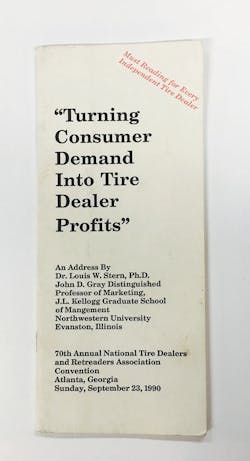Have you ever read something that just hit you like a ton of bricks because its truth and potential impact were immediately understood? When I run across material like this, I save it. When I refer to it later, I’m often amazed that the truth is more relevant now than when I first read it.
In 1990, my mentor, Bob Gatzke, handed me a small booklet regarding a presentation by the J.L. Kellogg Graduate School of Management at Northwestern University in Evanston, Ill. The title was “Turning Consumer Demand into Tire Dealer Profits.” Upon handing it to me, I could tell he had read it and understood its potential impact, and I remember him commenting that these studies help us see a little farther down the road. Much of what Dr. Louis W. Stern outlined in his address in September of 1990 is truer today than ever.
I’m going to list a few important comments Dr. Stern made and explore his comment regarding “power retailers” early in his presentation.
First, the marketing professor stated, “You can’t be all things to all people.” He was referencing that the challenge facing tire dealers to keep pace with the rapid changes in automotive technology would strain their ability to properly and profitably service automobiles. He suggested tire dealers focus and specialize in their service offerings, and commented they should stop focusing on the tire manufacturers, themselves, and focus on customers. He reminded the audience that we are retailers. I quote him here, “I believe tire dealers are retailers. You are retailing institutions. You’re not something different or something special or something else. You’re in the retail business.”
He then, as a professor, assigned the audience a homework assignment asking the dealers to pick up a copy of Fortune magazine’s Sept. 24, 1990, issue to read the article titled “The New Champs of Retailing.” He called it a must read. As he expanded on power retailing, he made reference to Home Depot, Nordstrom, Wal-Mart, and others, one of which was a company called IKEA. He spelled it out, I-K-E-A, and said, “You probably don’t even know who they are. They are Swedish.” He commented they were “knocking the pins” out of the furniture industry.This is where I’d like to pick up from Dr. Stern and make a few comments of my own. I’m doing a self-funded study on power retailers because I’m a former tire dealer, and I find retailing fascinating, energizing, and full of opportunity. Retailing is currently undergoing its most significant shift in relevancy as the popularity of online shopping is increasing dramatically.
To start, I agree with Dr. Stern; focus and specialization are key to tire retailers, and now is the time for a healthy re-evaluation and refocus.Let’s look at a slice of what IKEA has accomplished and discover if we can learn something from their marketing. IKEA is the number one retailer of furniture in the world, and they account for 1% of all worldwide annual usage of wood. They print 175,000,000 catalogs a year. They operate close to 400 stores globally, and their largest store is in South Korea at over 600,000 square feet.
My observation is everything starts with the catalog. To help produce the content, they operate the largest photo studio in Europe, 86,000 square feet. The catalog is a work of art and science; it is so well organized and inspiring that people pour over the pages for ideas for their homes. Next, the catalog is smartphone compatible with videos and photo galleries. Their website showcases over 12,000 products and receives 2.1 billion visits per year.
Lastly, the store is like a life-size catalog. The furniture and goods are staged in inspiring fashion with plenty of knowledgeable sales associates to assist the thousands of daily visitors walking the pathway (The Way) through the store.
My point, IKEA is a retailer, as we are retailers. They start with a focused plan, and they use their assets such as the photo studio to help execute their plan. They further their execution using digital initiatives like their website to deliver millions of customers.
For IKEA, it’s planning, printing, digital and physical. Important note: Inside the stores they use a combination of catalogs and digital solutions in conjunction with trained and knowledgeable associates. As Dr. Stern would probably encourage us, we’re retailers. The best retailers today use print, digital, physical, and assisted selling to meet their goals.
Can we improve our focus, our offerings of products and services, our execution of our plan? As retailers, we must. Winners win. ■
Wayne Williams is president of ExSell Marketing Inc., a “counter intelligence” firm based in La Habra, Calif. He can be reached at [email protected].
To read more Counter Intelligence articles, see:
I Got Schooled by a School Teacher
Customer-Service Revolution: How the 'User Experience' WIll Trump Price by 2020
At the Sales Counter: Focus on Feelings Supported by Facts
The Sales Counter Moved Again: And the Sales Floor is Now on the Smartphone
About the Author

Bob Ulrich
Bob Ulrich was named Modern Tire Dealer editor in August 2000 and retired in January 2020. He joined the magazine in 1985 as assistant editor, and had been responsible for gathering statistical information for MTD's "Facts Issue" since 1993. He won numerous awards for editorial and feature writing, including five gold medals from the International Automotive Media Association. Bob earned a B.A. in English literature from Ohio Northern University and has a law degree from the University of Akron.
